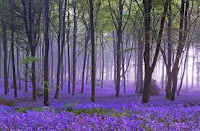Bluebells are native to the British Isles and Ireland, although there seems to be a little confusion surrounding them. The “bluebell of Scotland” is the harebell, Campinula rotundifolia which is a completely different flower. This is usually a single flower on a stalk, but bluebells have many bell shaped flowers on a single stalk, and the native British bluebell has a heady fragrance. The invading species of Spanish bluebell is Hyacinthoides hispanica, which is easy to distinguish from the British variety as it doesn’t have a fragrance, has paler blue flowers, is taller, is more upright and has wider leaves. The British variety is now a protected species, under the 1998 Wildlife and Countryside Act so unfortunately it is illegal to collect them. However they were abundant in the woods where I grew up and there were no restrictions on picking them, although no one I knew ever uprooted them. This may have been because of an ancient superstition, which says that anyone who picks or damages a bluebell will die because they are fairy flowers. It was thought that the fairies rang the bluebells to call a fairy meeting and any human who heard the bells ringing would die, or fall under the enchantment of the fairies. In some parts of the country it was believed that you shouldn’t walk into a ring of bluebells because you would fall under a spell or die. They are sometimes called Dead Man’s Bells. When I was young I had no idea that they were a flower of doom, but knew them as fairy flowers, which was not something to fear.
Another superstition is that if someone wears a garland of bluebells they are compelled to tell the truth. Also if you are a young woman and can turn a single bluebell flower inside out without tearing or damaging it, you will win the one you love.
The Daily Telegraph newspaper in Britain keeps a close watch on bluebells and got very excited in 2009 and again in may 2010 when white bluebells were found. I have often seen them growing along with pink ones and knew they were rare, although I hadn’t realized (because there were always a fair number of them) that a white bluebell occurs once in every 10,000. We had pink ones in the woods too and these are even rarer, I have since learned. In 2008 it reported that the bluebells had flowered a month early on the 3rd of March, possibly because of global warming.
 Bluebells along with wild wood anemones, foxgloves, primroses, sorrel and dog violets indicate places where ancient forests (pre1600) once stood. If you have these in your garden, then it is likely that your house in built on ancient forest land.
Bluebells along with wild wood anemones, foxgloves, primroses, sorrel and dog violets indicate places where ancient forests (pre1600) once stood. If you have these in your garden, then it is likely that your house in built on ancient forest land. These flowers attract bees and butterflies, and the 19th century poet laureate, Alfred, Lord Tennyson, waxed poetically lyrical about them. Here are some of his lines:
“In the month when earth and sky are one,
To squeeze the bluebell ‘gainst the adder’s bite”
And “The heaven’s upbreaking through the earth” was how he described the bluebell in flower, which it does normally around April and May. Juice from the bluebell stems was an old remedy for poisonous bites; the adder mentioned by Tennyson is the viper, the only poisonous snake native to the British Isles.
Britain actually has 30% of the world’s population of bluebells, which grow in North America, North Africa, Western Europe, the Iberian Peninsula and Central France. They can also be found along the Mediterranean as far as Italy.
The plant was first called Hyacinthus by the botanist Linnaeus, because of their resemblance to the wild hyacinth which meant that he associated it with the Greek myth of the youth Hyacinth who was beloved of Apollo the Sun god and Zephyrus the god of the West Wind. Hyacinth loved Apollo best and the jealous West Wind sent a quoit in the wrong direction while Hyacinth was playing quoits with Apollo, and he was killed by its blow. In his grief, Apollo caused a hyacinth flower to grow from the blood of Hyacinth and the letters Ai Ai (alas, alas) were written on it. The bluebell was called Hyacinth nonscripta because it was not written upon.
In the language of flowers the bluebell means constancy, humility and gratitude and is a symbol of humility and gratitude.
 Traditionally the bluebell root was used as a styptic (which stops bleeding by contracting the bleed vessels and tissue) and diuretic, and also as a substitute for starch when huge white ruffs were fashionable (Elizabethan and Jacobean times). The bulb contains inulin and mucilage and trials are underway to teat the efficacy of the bluebell for the treatments of infections stemming from HIV and cancer treatments, but the trials are still in the early stages.
Traditionally the bluebell root was used as a styptic (which stops bleeding by contracting the bleed vessels and tissue) and diuretic, and also as a substitute for starch when huge white ruffs were fashionable (Elizabethan and Jacobean times). The bulb contains inulin and mucilage and trials are underway to teat the efficacy of the bluebell for the treatments of infections stemming from HIV and cancer treatments, but the trials are still in the early stages.



